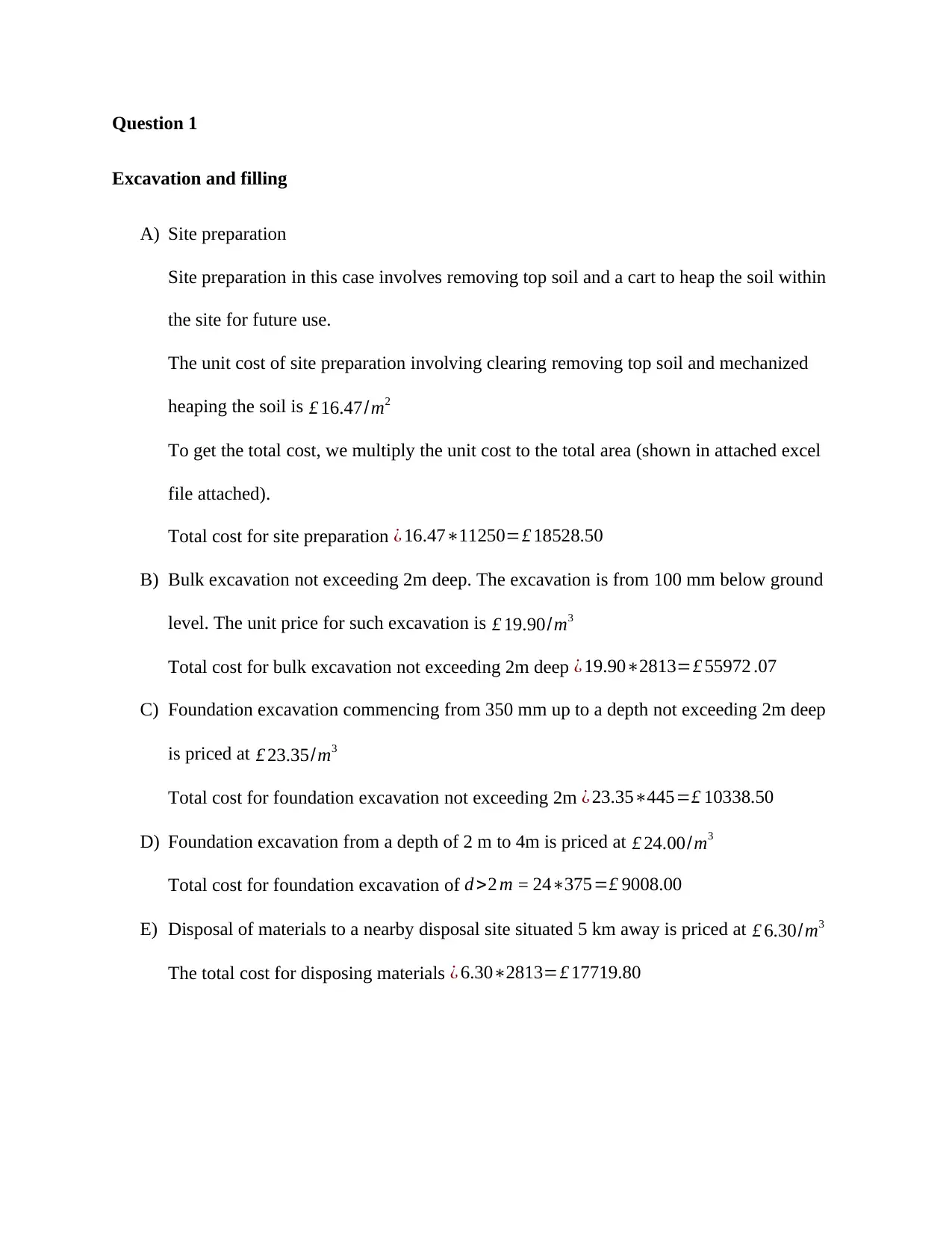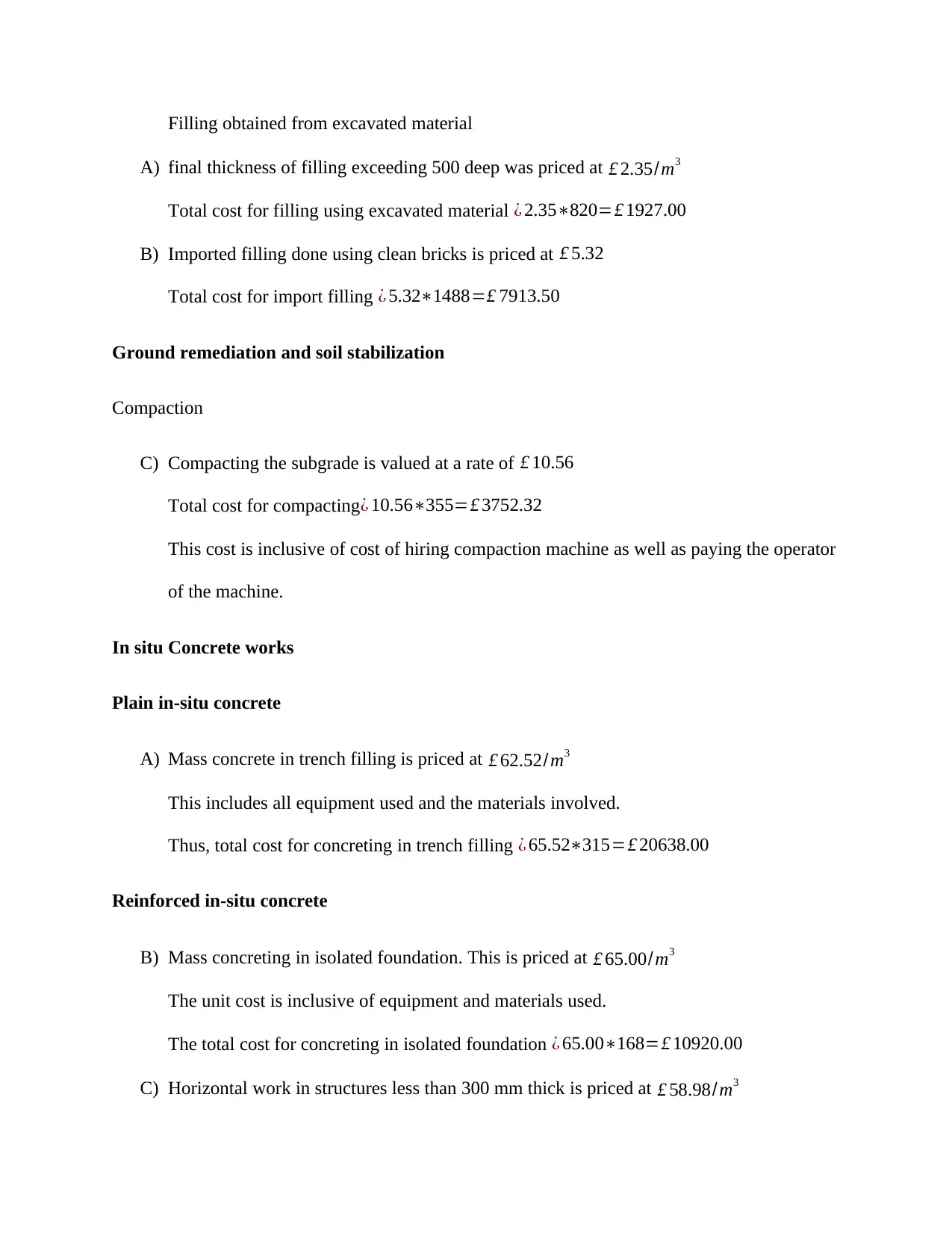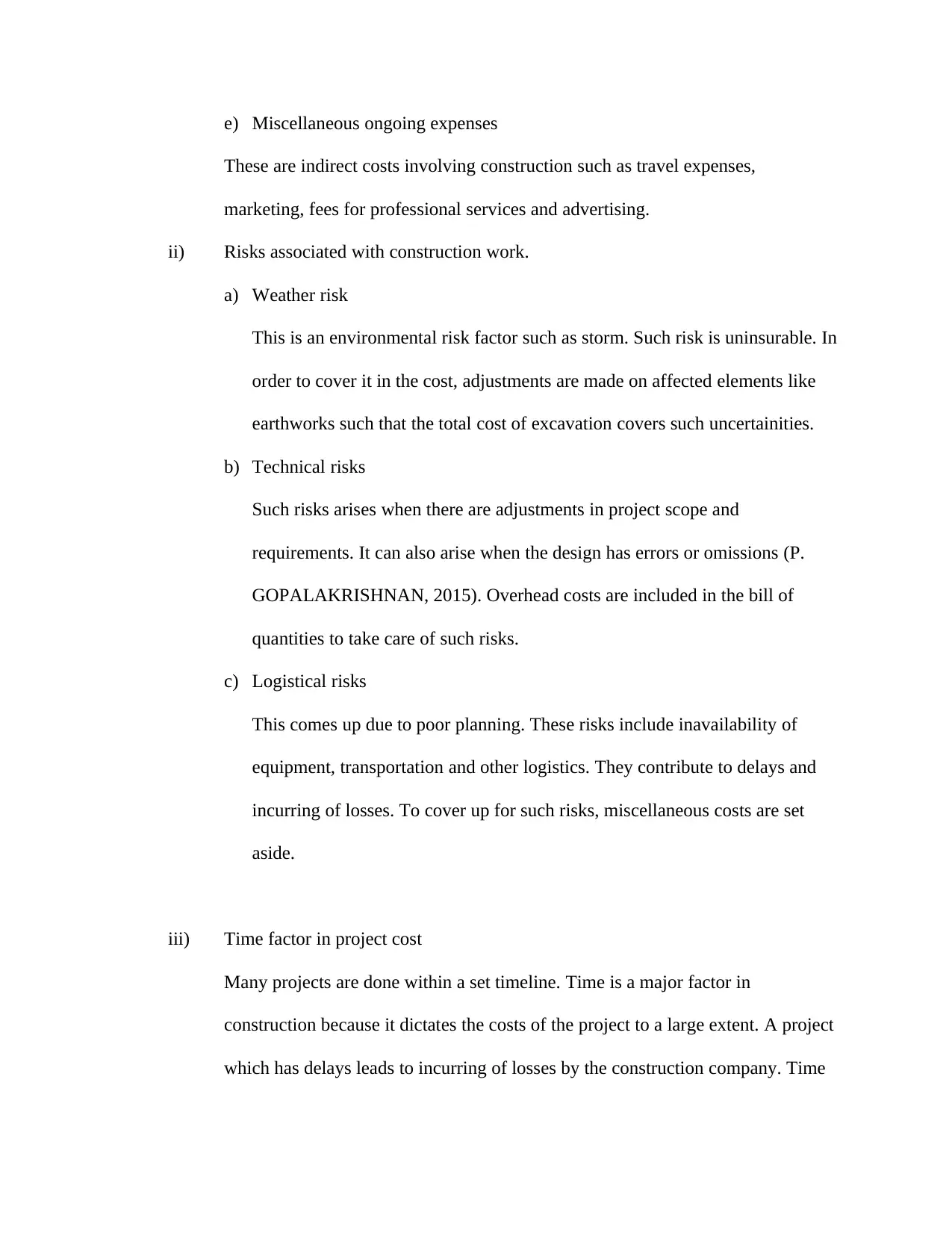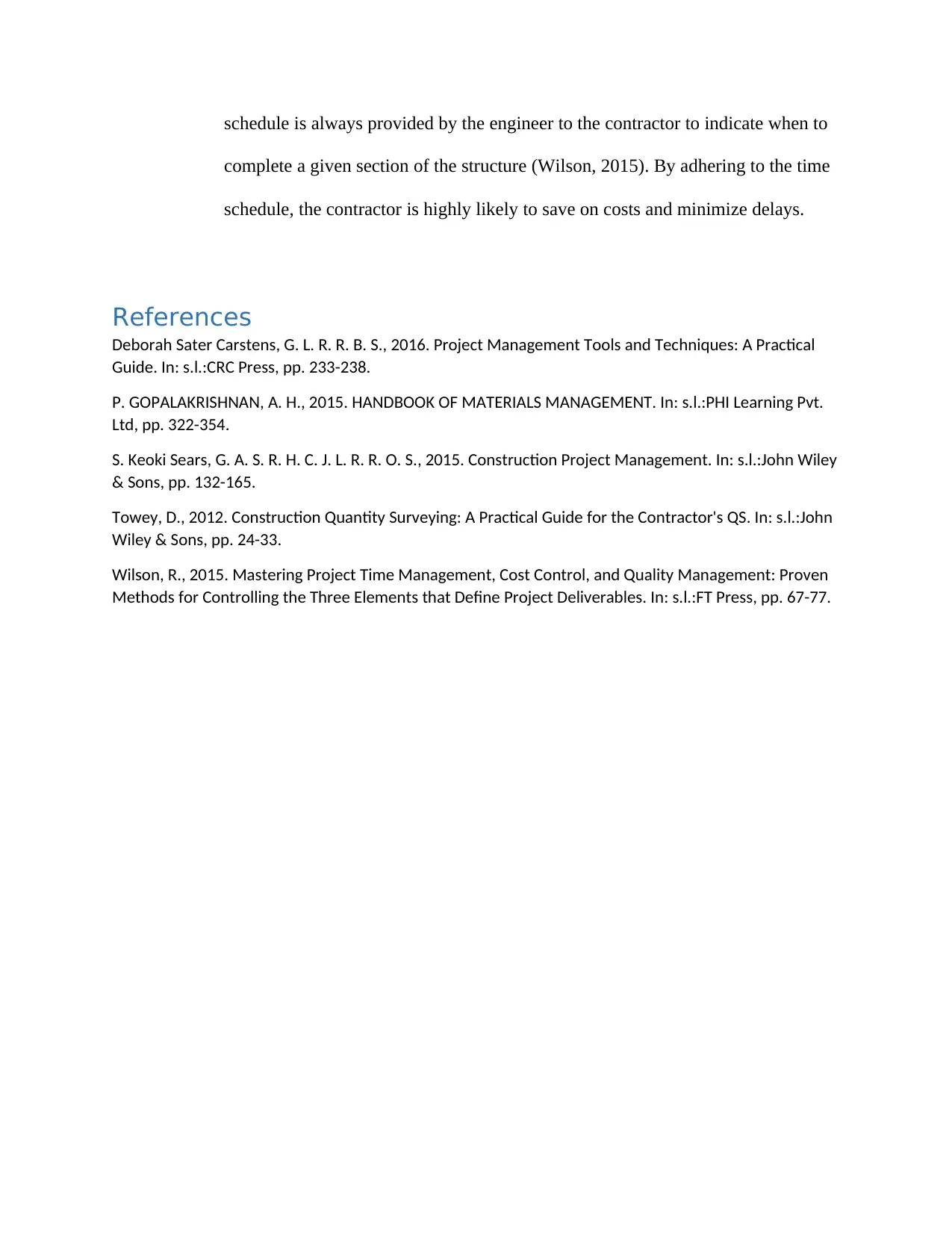School of Engineering: MMK225201 Estimating Homework - GCU
VerifiedAdded on 2023/01/19
|6
|1237
|33
Homework Assignment
AI Summary
This document presents a comprehensive solution to a civil engineering estimating homework assignment, addressing the quantification and costing of various groundworks. The solution includes detailed pricing for site preparation, excavation (bulk and foundation), disposal of materials, filling, ground remediation, concrete works (plain and reinforced), and masonry. The calculations incorporate unit costs, total costs, and profit margins, as specified in the assignment brief. Question 1 focuses on pricing works based on bills of quantities, outlining rate build-up calculations. Question 2 delves into overhead costs, including administrative salaries, temporary office structures, foreman salaries, equipment costs, and miscellaneous expenses. It also addresses construction risks (weather, technical, and logistical) and the impact of time factors on project costs. References from relevant sources are provided to support the analysis.

Question 1
Excavation and filling
A) Site preparation
Site preparation in this case involves removing top soil and a cart to heap the soil within
the site for future use.
The unit cost of site preparation involving clearing removing top soil and mechanized
heaping the soil is £ 16.47/m2
To get the total cost, we multiply the unit cost to the total area (shown in attached excel
file attached).
Total cost for site preparation ¿ 16.47∗11250=£ 18528.50
B) Bulk excavation not exceeding 2m deep. The excavation is from 100 mm below ground
level. The unit price for such excavation is £ 19.90/m3
Total cost for bulk excavation not exceeding 2m deep ¿ 19.90∗2813=£ 55972 .07
C) Foundation excavation commencing from 350 mm up to a depth not exceeding 2m deep
is priced at £ 23.35/m3
Total cost for foundation excavation not exceeding 2m ¿ 23.35∗445=£ 10338.50
D) Foundation excavation from a depth of 2 m to 4m is priced at £ 24.00/m3
Total cost for foundation excavation of d >2 m = 24∗375=£ 9008.00
E) Disposal of materials to a nearby disposal site situated 5 km away is priced at £ 6.30/m3
The total cost for disposing materials ¿ 6.30∗2813=£ 17719.80
Excavation and filling
A) Site preparation
Site preparation in this case involves removing top soil and a cart to heap the soil within
the site for future use.
The unit cost of site preparation involving clearing removing top soil and mechanized
heaping the soil is £ 16.47/m2
To get the total cost, we multiply the unit cost to the total area (shown in attached excel
file attached).
Total cost for site preparation ¿ 16.47∗11250=£ 18528.50
B) Bulk excavation not exceeding 2m deep. The excavation is from 100 mm below ground
level. The unit price for such excavation is £ 19.90/m3
Total cost for bulk excavation not exceeding 2m deep ¿ 19.90∗2813=£ 55972 .07
C) Foundation excavation commencing from 350 mm up to a depth not exceeding 2m deep
is priced at £ 23.35/m3
Total cost for foundation excavation not exceeding 2m ¿ 23.35∗445=£ 10338.50
D) Foundation excavation from a depth of 2 m to 4m is priced at £ 24.00/m3
Total cost for foundation excavation of d >2 m = 24∗375=£ 9008.00
E) Disposal of materials to a nearby disposal site situated 5 km away is priced at £ 6.30/m3
The total cost for disposing materials ¿ 6.30∗2813=£ 17719.80
Paraphrase This Document
Need a fresh take? Get an instant paraphrase of this document with our AI Paraphraser

Filling obtained from excavated material
A) final thickness of filling exceeding 500 deep was priced at £ 2.35/m3
Total cost for filling using excavated material ¿ 2.35∗820=£ 1927.00
B) Imported filling done using clean bricks is priced at £ 5.32
Total cost for import filling ¿ 5.32∗1488=£ 7913.50
Ground remediation and soil stabilization
Compaction
C) Compacting the subgrade is valued at a rate of £ 10.56
Total cost for compacting ¿ 10.56∗355=£ 3752.32
This cost is inclusive of cost of hiring compaction machine as well as paying the operator
of the machine.
In situ Concrete works
Plain in-situ concrete
A) Mass concrete in trench filling is priced at £ 62.52/m3
This includes all equipment used and the materials involved.
Thus, total cost for concreting in trench filling ¿ 65.52∗315=£ 20638.00
Reinforced in-situ concrete
B) Mass concreting in isolated foundation. This is priced at £ 65.00/m3
The unit cost is inclusive of equipment and materials used.
The total cost for concreting in isolated foundation ¿ 65.00∗168=£ 10920.00
C) Horizontal work in structures less than 300 mm thick is priced at £ 58.98/m3
A) final thickness of filling exceeding 500 deep was priced at £ 2.35/m3
Total cost for filling using excavated material ¿ 2.35∗820=£ 1927.00
B) Imported filling done using clean bricks is priced at £ 5.32
Total cost for import filling ¿ 5.32∗1488=£ 7913.50
Ground remediation and soil stabilization
Compaction
C) Compacting the subgrade is valued at a rate of £ 10.56
Total cost for compacting ¿ 10.56∗355=£ 3752.32
This cost is inclusive of cost of hiring compaction machine as well as paying the operator
of the machine.
In situ Concrete works
Plain in-situ concrete
A) Mass concrete in trench filling is priced at £ 62.52/m3
This includes all equipment used and the materials involved.
Thus, total cost for concreting in trench filling ¿ 65.52∗315=£ 20638.00
Reinforced in-situ concrete
B) Mass concreting in isolated foundation. This is priced at £ 65.00/m3
The unit cost is inclusive of equipment and materials used.
The total cost for concreting in isolated foundation ¿ 65.00∗168=£ 10920.00
C) Horizontal work in structures less than 300 mm thick is priced at £ 58.98/m3

This composes of equipment and materials used.
Total cost for horizontal work ¿ 58.98∗761=£ 44883.78
Masonry
A) Brick work ; engineering bricks; in cement mortar ratio 1:4
The cavity wall will be half brick thick. The unit price for the materials that is cement
mortar plus the bricks is £ 6 .52.
The total cost for brick work ¿ 6 .52∗275=£ 1789 .74
B) Block work 100 mm thick made up of concrete blocks. Face size is 440*125 mm
(Towey, 2012). The unit price for the block work described is £ 15.30
The total cost of the block work ¿ 15.30∗275=£ 4199.85
Summing up the costs, we get;
Cost of construction ¿ £ 374350.86
The profit margin = 3%
Profit ¿ 3
100∗374350.86=£ 11230.53
Overhead = 4%
Overhead ¿ 4
100∗374350.86=£ 14974.03
This means that, the total cost of construction will be ¿ 374350.86+11230.53+14974.03
Total cost=£ 400555.42
Total cost for horizontal work ¿ 58.98∗761=£ 44883.78
Masonry
A) Brick work ; engineering bricks; in cement mortar ratio 1:4
The cavity wall will be half brick thick. The unit price for the materials that is cement
mortar plus the bricks is £ 6 .52.
The total cost for brick work ¿ 6 .52∗275=£ 1789 .74
B) Block work 100 mm thick made up of concrete blocks. Face size is 440*125 mm
(Towey, 2012). The unit price for the block work described is £ 15.30
The total cost of the block work ¿ 15.30∗275=£ 4199.85
Summing up the costs, we get;
Cost of construction ¿ £ 374350.86
The profit margin = 3%
Profit ¿ 3
100∗374350.86=£ 11230.53
Overhead = 4%
Overhead ¿ 4
100∗374350.86=£ 14974.03
This means that, the total cost of construction will be ¿ 374350.86+11230.53+14974.03
Total cost=£ 400555.42
⊘ This is a preview!⊘
Do you want full access?
Subscribe today to unlock all pages.

Trusted by 1+ million students worldwide

Question 2
i) Five items to be included in overhead cost.
a) Salaries of administrative employees.
These employees do not work on the actual job site. They are involved in
administrative work such as keeping records, planning and other administrative
chores. Administrative employees are integral part in coordination and execution
of secondary activities such as financial flow within the period of construction (S.
Keoki Sears, 2015).
b) Temporary office structures.
These are the rooms which will be used by senior workers such as architects,
engineers and contractor. They are essential because they act as meeting places
during site meetings and site inspection.
c) Salaries for foremen
This is a direct expense. They are tied to the project being undertaken. Foremen
are at the site to coordinate technicians and other junior workers. They do not do
the actual work but are tasked with assigning work to other junior workers at the
site (Deborah Sater Carstens, 2016).
d) Equipment costs
These are the expenses incurred in buying and renting automobiles, excavators
and any machine or tool used in construction. These are direct costs incurred in
construction work.
i) Five items to be included in overhead cost.
a) Salaries of administrative employees.
These employees do not work on the actual job site. They are involved in
administrative work such as keeping records, planning and other administrative
chores. Administrative employees are integral part in coordination and execution
of secondary activities such as financial flow within the period of construction (S.
Keoki Sears, 2015).
b) Temporary office structures.
These are the rooms which will be used by senior workers such as architects,
engineers and contractor. They are essential because they act as meeting places
during site meetings and site inspection.
c) Salaries for foremen
This is a direct expense. They are tied to the project being undertaken. Foremen
are at the site to coordinate technicians and other junior workers. They do not do
the actual work but are tasked with assigning work to other junior workers at the
site (Deborah Sater Carstens, 2016).
d) Equipment costs
These are the expenses incurred in buying and renting automobiles, excavators
and any machine or tool used in construction. These are direct costs incurred in
construction work.
Paraphrase This Document
Need a fresh take? Get an instant paraphrase of this document with our AI Paraphraser

e) Miscellaneous ongoing expenses
These are indirect costs involving construction such as travel expenses,
marketing, fees for professional services and advertising.
ii) Risks associated with construction work.
a) Weather risk
This is an environmental risk factor such as storm. Such risk is uninsurable. In
order to cover it in the cost, adjustments are made on affected elements like
earthworks such that the total cost of excavation covers such uncertainities.
b) Technical risks
Such risks arises when there are adjustments in project scope and
requirements. It can also arise when the design has errors or omissions (P.
GOPALAKRISHNAN, 2015). Overhead costs are included in the bill of
quantities to take care of such risks.
c) Logistical risks
This comes up due to poor planning. These risks include inavailability of
equipment, transportation and other logistics. They contribute to delays and
incurring of losses. To cover up for such risks, miscellaneous costs are set
aside.
iii) Time factor in project cost
Many projects are done within a set timeline. Time is a major factor in
construction because it dictates the costs of the project to a large extent. A project
which has delays leads to incurring of losses by the construction company. Time
These are indirect costs involving construction such as travel expenses,
marketing, fees for professional services and advertising.
ii) Risks associated with construction work.
a) Weather risk
This is an environmental risk factor such as storm. Such risk is uninsurable. In
order to cover it in the cost, adjustments are made on affected elements like
earthworks such that the total cost of excavation covers such uncertainities.
b) Technical risks
Such risks arises when there are adjustments in project scope and
requirements. It can also arise when the design has errors or omissions (P.
GOPALAKRISHNAN, 2015). Overhead costs are included in the bill of
quantities to take care of such risks.
c) Logistical risks
This comes up due to poor planning. These risks include inavailability of
equipment, transportation and other logistics. They contribute to delays and
incurring of losses. To cover up for such risks, miscellaneous costs are set
aside.
iii) Time factor in project cost
Many projects are done within a set timeline. Time is a major factor in
construction because it dictates the costs of the project to a large extent. A project
which has delays leads to incurring of losses by the construction company. Time

schedule is always provided by the engineer to the contractor to indicate when to
complete a given section of the structure (Wilson, 2015). By adhering to the time
schedule, the contractor is highly likely to save on costs and minimize delays.
References
Deborah Sater Carstens, G. L. R. R. B. S., 2016. Project Management Tools and Techniques: A Practical
Guide. In: s.l.:CRC Press, pp. 233-238.
P. GOPALAKRISHNAN, A. H., 2015. HANDBOOK OF MATERIALS MANAGEMENT. In: s.l.:PHI Learning Pvt.
Ltd, pp. 322-354.
S. Keoki Sears, G. A. S. R. H. C. J. L. R. R. O. S., 2015. Construction Project Management. In: s.l.:John Wiley
& Sons, pp. 132-165.
Towey, D., 2012. Construction Quantity Surveying: A Practical Guide for the Contractor's QS. In: s.l.:John
Wiley & Sons, pp. 24-33.
Wilson, R., 2015. Mastering Project Time Management, Cost Control, and Quality Management: Proven
Methods for Controlling the Three Elements that Define Project Deliverables. In: s.l.:FT Press, pp. 67-77.
complete a given section of the structure (Wilson, 2015). By adhering to the time
schedule, the contractor is highly likely to save on costs and minimize delays.
References
Deborah Sater Carstens, G. L. R. R. B. S., 2016. Project Management Tools and Techniques: A Practical
Guide. In: s.l.:CRC Press, pp. 233-238.
P. GOPALAKRISHNAN, A. H., 2015. HANDBOOK OF MATERIALS MANAGEMENT. In: s.l.:PHI Learning Pvt.
Ltd, pp. 322-354.
S. Keoki Sears, G. A. S. R. H. C. J. L. R. R. O. S., 2015. Construction Project Management. In: s.l.:John Wiley
& Sons, pp. 132-165.
Towey, D., 2012. Construction Quantity Surveying: A Practical Guide for the Contractor's QS. In: s.l.:John
Wiley & Sons, pp. 24-33.
Wilson, R., 2015. Mastering Project Time Management, Cost Control, and Quality Management: Proven
Methods for Controlling the Three Elements that Define Project Deliverables. In: s.l.:FT Press, pp. 67-77.
⊘ This is a preview!⊘
Do you want full access?
Subscribe today to unlock all pages.

Trusted by 1+ million students worldwide
1 out of 6
Your All-in-One AI-Powered Toolkit for Academic Success.
+13062052269
info@desklib.com
Available 24*7 on WhatsApp / Email
![[object Object]](/_next/static/media/star-bottom.7253800d.svg)
Unlock your academic potential
Copyright © 2020–2026 A2Z Services. All Rights Reserved. Developed and managed by ZUCOL.
